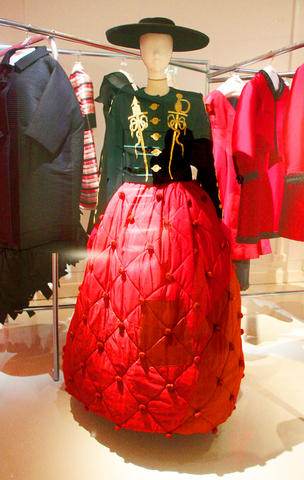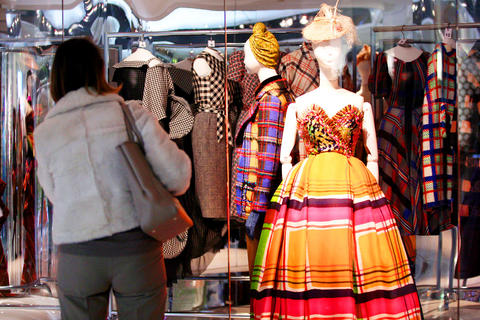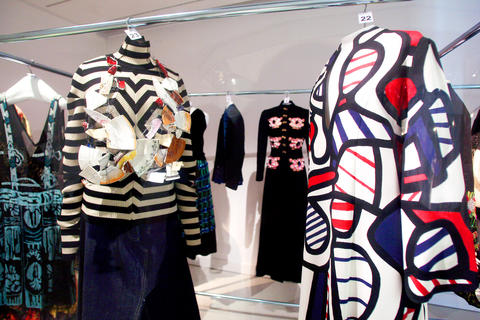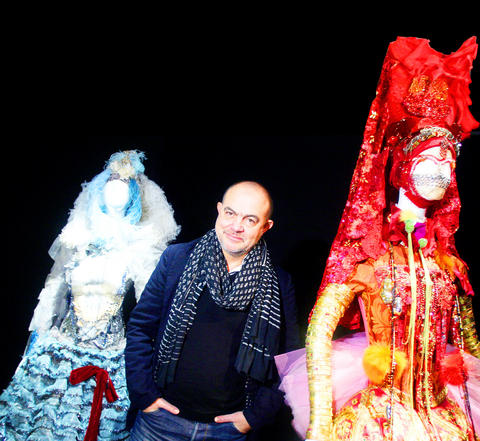Christian Lacroix, arguably the most extravagant couturier in Paris, never intended to be a fashion designer. His dream was to be a museum curator, a wish that finally came true via a breath-taking walk through two centuries of fashion.
For the past couple of years, Lacroix, 56 this year, spent most of his Friday mornings picking through 80,000 items of clothing old and new stocked at France's Decorative Arts Museum next door to the Louvre.
To mark the 20th anniversary of his own couture house this year, the museum had offered a show of his own lavish designs. But Lacroix declined.

PHOTO: AFP
"A self-promoting retrospective would have been a bit vulgar," he said.
"I wanted to show that my work is based on the wealth of museums such as this one."
Obsessed with costume since the age of six, and a dedicated history of art student who nonetheless failed France's tough museum curator exams, Lacroix narrowed down his choice of clothes to 1,400 then 500 "of the most inspiring items recounting the history of fashion."

PHOTO: AFP
At the show, titled Christian Lacroix, Histoires de Mode (History of Fashion) and running until April 20 next year, a final 400 dresses, capes, coats and hats dating back to the 18th century are displayed in counterpoint to 90 emblematic designs from Lacroix's own twice-yearly haute couture shows.
Alongside his iconic stripes from 1987 hang striped bustles and crinolines from the 1860s, while a black-and-white spotted 2001 number worn with a red crocodile-skin jacket stands by a red-spotted Schiaparelli evening coat from 1939 and a 1940 Lanvin gown in black and white spots.
There are groups of dresses in spots, stripes, checks, lames, flowery patterns, netting or patchwork. Gathered together by color, fabric, style or inspiration, the exhibition highlights how fashion constantly reinvents itself, said co-curator Olivier Saillard.

PHOTO: AFP
"Christian Lacroix is someone whose work is inspired by history and shows fashions coming around over and over again," said Saillard. "Fashion always repeats itself."
Celebrated for his exuberant swathes of lace and embroidery, and patchworks of fabrics in vibrant colors, Christian Lacroix hit the catwalks 20 years ago with dramatic designs inspired by the costumes of his native Arles in the south of France, and the Camargue, with its gypsies and bullfighters.
But while his roots remain an inspiration, he is known more than any other of the great French couturiers for harking back to the history of costume in his stunning fashion collections.

PHOTO: AFP
Along with dresses from the 18th and 19th centuries, the show features models by Lacroix contemporaries such as Yohji Yamamoto, Comme des Garcons or Yves Saint Laurent, alongside post-war classics from Christian Dior or Pierre Cardin as well as creations by early couture czars Worth, Poiret and Jeanne Lanvin.
"There are not only the big names but also anonymously-made clothing," Lacroix said. "The show is a hymn to Parisian couture."

June 9 to June 15 A photo of two men riding trendy high-wheel Penny-Farthing bicycles past a Qing Dynasty gate aptly captures the essence of Taipei in 1897 — a newly colonized city on the cusp of great change. The Japanese began making significant modifications to the cityscape in 1899, tearing down Qing-era structures, widening boulevards and installing Western-style infrastructure and buildings. The photographer, Minosuke Imamura, only spent a year in Taiwan as a cartographer for the governor-general’s office, but he left behind a treasure trove of 130 images showing life at the onset of Japanese rule, spanning July 1897 to

One of the most important gripes that Taiwanese have about the Democratic Progressive Party (DPP) is that it has failed to deliver concretely on higher wages, housing prices and other bread-and-butter issues. The parallel complaint is that the DPP cares only about glamor issues, such as removing markers of Chinese Nationalist Party (KMT) colonialism by renaming them, or what the KMT codes as “de-Sinification.” Once again, as a critical election looms, the DPP is presenting evidence for that charge. The KMT was quick to jump on the recent proposal of the Ministry of the Interior (MOI) to rename roads that symbolize

On the evening of June 1, Control Yuan Secretary-General Lee Chun-yi (李俊俋) apologized and resigned in disgrace. His crime was instructing his driver to use a Control Yuan vehicle to transport his dog to a pet grooming salon. The Control Yuan is the government branch that investigates, audits and impeaches government officials for, among other things, misuse of government funds, so his misuse of a government vehicle was highly inappropriate. If this story were told to anyone living in the golden era of swaggering gangsters, flashy nouveau riche businessmen, and corrupt “black gold” politics of the 1980s and 1990s, they would have laughed.

It was just before 6am on a sunny November morning and I could hardly contain my excitement as I arrived at the wharf where I would catch the boat to one of Penghu’s most difficult-to-access islands, a trip that had been on my list for nearly a decade. Little did I know, my dream would soon be crushed. Unsure about which boat was heading to Huayu (花嶼), I found someone who appeared to be a local and asked if this was the right place to wait. “Oh, the boat to Huayu’s been canceled today,” she told me. I couldn’t believe my ears. Surely,